Tunnel Slotting-Blasting Numerical Modeling Using Rock Tension-Compression Coupling Damage Algorithm
Abstract
:1. Introduction
2. Methodology
2.1. Relationship of Stress-Strain with Damage Variable
2.2. Elastic-Plastic Model and Yield Criteria
2.3. Tension-Compression Coupled Damage Equation
- (1)
- Rock micro-bodies and rock damage all are isotropic in the macroscopic.
- (2)
- Rock micro-bodies without damage obey Hooke’s law before micro-bodies are destroyed.
- (3)
- The strength of each micro-body obeys the Weibull probability distribution. Because the Weibull probability distribution meets the statistical characteristics of rock compression failure, the probability density function of each micro-body strength obeys the Weibull distribution of two parameters. The probability density function of the Weibull distribution is denoted by Equation (13).where is the distribution variable of random distribution of rock micro-body strength; , are Weibull’s distribution parameters related to rock mechanical properties.
3. Numerical Algorithm of Elastic-Plastic Damage Coupled Model
4. Validation of the Availability of Proposed Model
4.1. Numerical Simulation of Single-Column Explosives Blasting Test
4.2. Analysis of Dynamic Variable Characteristics
4.3. Blasting Damage Evolution Law of Slot Cavity
5. Case Study
5.1. Blasting Damage Simulation of Surrounding Rock with Six Slot Bores
5.2. Results
5.3. Discussion
6. Conclusions
- The proposed weighted damage calculation method may measure the coupling effect of tension damage and compression damage under blasting load.
- Compared with the calculation results using the classical PLASTIC-KINEMATIC model, the proposed model of rock blasting damage may better simulate the variation laws of effective stress, acceleration and velocity with time under blasting load.
- It is available that the proposed model of rock blasting damage is used to investigate the blasting damage evolution law of rock in the process of slotting-blasting.
- The engineering application shows that using the proposed model of rock blasting damage may investigate the generating process of slot cavity and the damage law of surrounding rock in the slotting-blasting construction of rock tunnel.
Author Contributions
Funding
Institutional Review Board Statement
Informed Consent Statement
Data Availability Statement
Conflicts of Interest
References
- Li, X.P.; Chen, J.; Li, Y.H.; Dai, Y.F. Study of criterion and damage zone induced by excavation blasting of underground power-house of Xiluodu hydropower station. Chin. J. Rock Mech. Eng. 2010, 29, 2042–2049. [Google Scholar]
- Hu, Y.G.; Lu, W.B.; Chen, M.; Yan, P.; Zhou, C.B. Comparison and improvement of blasting damage models for rock. Rock Soil Mech. 2012, 33, 3278–3284. [Google Scholar]
- Lu, W.; Yang, J.; Chen, M.; Zhou, C. Mechanism and equivalent numerical simulation of transient release of excavation load for deep tunnel. Chin. J. Rock Mech. Eng. 2011, 30, 1089–1096. [Google Scholar]
- Yang, R.; Bawden, W.F.; Katsabanis, P.D. A new constitutive model for blast damage. Int. J. Rock Mech. Min. Geomech. Abstr. 1996, 33, 245–254. [Google Scholar] [CrossRef]
- Liu, L.; Katsabanis, P.D. Development of a continuum damage model for blasting analysis. Int. J. Rock Mech. Min. 1997, 34, 217–231. [Google Scholar] [CrossRef]
- Deng, X.F.; Zhu, J.B.; Chen, S.G.; Zhao, Z.Y.; Zhou, Y.X.; Zhao, J. Numerical study on tunnel damage subject to blast-induced shock wave in jointed rock masses. Tunn. Undergr. Space Technol. 2014, 43, 88–100. [Google Scholar] [CrossRef]
- Deng, X.F.; Chen, S.G.; Zhu, J.B.; Zhou, Y.X.; Zhao, Z.Y.; Zhao, J. UDEC-Autodyn hybrid modeling of a large-scale underground explosion test. Rock Mech. Rock Eng. 2015, 48, 737–747. [Google Scholar] [CrossRef]
- Chen, J.H.; Zhang, J.S.; Li, X.P. Model of rock blasting-induced damage considering integrity of rock mass and its application. Rock Soil Mech. 2016, 38, 857–866. [Google Scholar]
- Xie, L.X.; Lu, W.B.; Zhang, Q.B.; Jiang, Q.H.; Wang, G.H.; Zhao, J. Damage evolution mechanisms of rock in deep tunnels induced by cut blasting. Tunn. Undergr. Space Technol. 2016, 58, 257–270. [Google Scholar] [CrossRef]
- Zhu, J.B.; Li, Y.S.; Wu, S.Y.; Zhang, R.; Ren, L. Decoupled explosion in an underground opening and dynamic responses of surrounding rock masses and structures and induced ground motions: A FEM-DEM numerical study. Tunn. Undergr. Space Technol. 2018, 82, 442–454. [Google Scholar] [CrossRef]
- Wang, F.; Tu, S.; Yuan, Y.; Feng, Y.F.; Chen, F.; Tu, H.S. Deep-Hole pre-split blasting mechanism and its application for controlled roof caving in shallow depth seams. Int. J. Rock Mech. Min. 2013, 64, 112–121. [Google Scholar] [CrossRef]
- Yang, J.H.; Lu, W.B.; Hu, Y.G.; Chen, M.; Yan, P. Numerical simulation of rock mass damage evolution during deep-buried tunnel excavation by drill and blast. Rock Mech. Rock Eng. 2015, 48, 2045–2059. [Google Scholar] [CrossRef]
- Tang, C. Numerical simulation of progressive rock failure and associated seismicity. Int. J. Rock Mech. Min. 1997, 34, 249–261. [Google Scholar] [CrossRef]
- Svedberg, T.; Runesson, K. An adaptive finite element algorithm for gradient theory of plasticity with coupling to damage. Int. J. Solids Struct. 2000, 37, 7481–7499. [Google Scholar] [CrossRef]
- Tang, C.A.; Tham, L.G.; Lee, P.K.K.; Yang, T.H.; Li, L.C. Coupled analysis of flow, stress and damage (FSD) in rock failure. Int. J. Rock. Mech. Min. 2002, 39, 477–489. [Google Scholar] [CrossRef]
- Cao, W.G.; Zhang, S.; Zhao, M.H. Study on statistical damage constitutive model of rock based on new definition of damage. Rock Soil Mech. 2006, 27, 41–46. [Google Scholar]
- Jiang, A.N.; Zheng, S.; Wang, S.Y. Stress-Seepage-Damage coupling modelling method for tunnel in rich water region. Eng. Comput. 2020, 37, 2659–2683. [Google Scholar] [CrossRef]
- Grady, D.E.; Kipp, M.E. Continuum modeling of explosive fracture in oil shale. Int. J. Rock Mech. Min. 1980, 17, 147–157. [Google Scholar] [CrossRef]
- Zhu, J.B.; Deng, X.F.; Zhao, X.B.; Zhao, J. A numerical study on wave transmission across multiple intersecting joint sets in rock masses with UDEC. Rock Mech. Rock Eng. 2013, 46, 1429–1442. [Google Scholar] [CrossRef]
- Liu, C.; Lu, Y.; Xia, B.; Yu, P. Directional fracturing by slotting-blasting-caused stress wave form changes. Int. J. Impact Eng. 2019, 129, 141–151. [Google Scholar] [CrossRef]
- Li, Q.; Gao, Z.H.; Yu, Q.; Huang, C.; Wang, K.; Xu, W.L. Effect of explosive stress waves on the crack propagation in the defective medium using strain gauge method. KSCE J. Civ. Eng. 2022, 26, 2780–2788. [Google Scholar] [CrossRef]
- Cowper, G.R.; Symonds, P.S. Strain Hardening and Strain Rate Effects in the Impact Loading of Cantilever Beams; Brown University: Providence, RI, USA, 1958. [Google Scholar]
- Lewis, B.A. Manual for LS-DYNA Soil Material Model 143; US Federal Highway Administration: Washington, DC, USA, 2014.
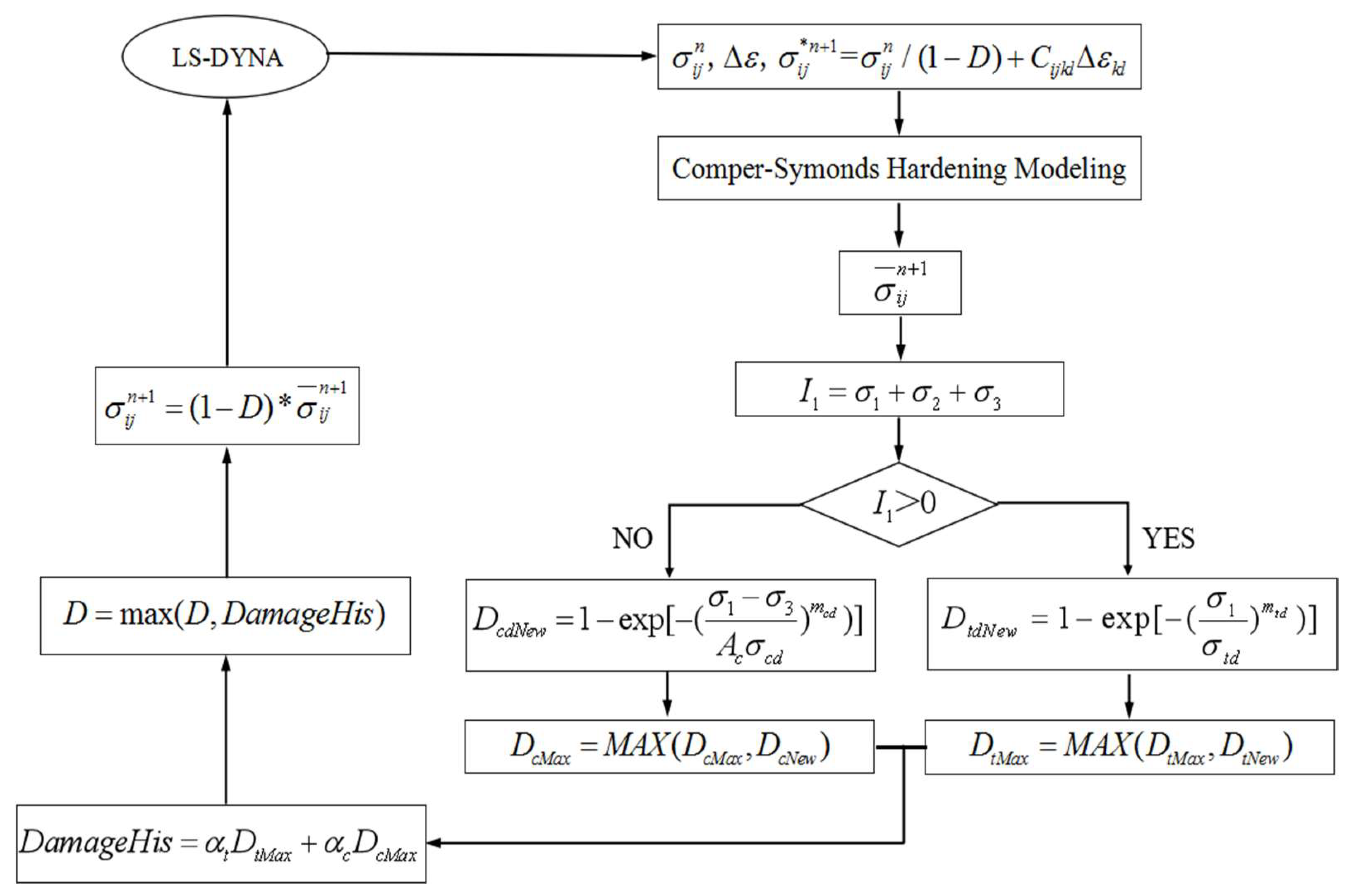
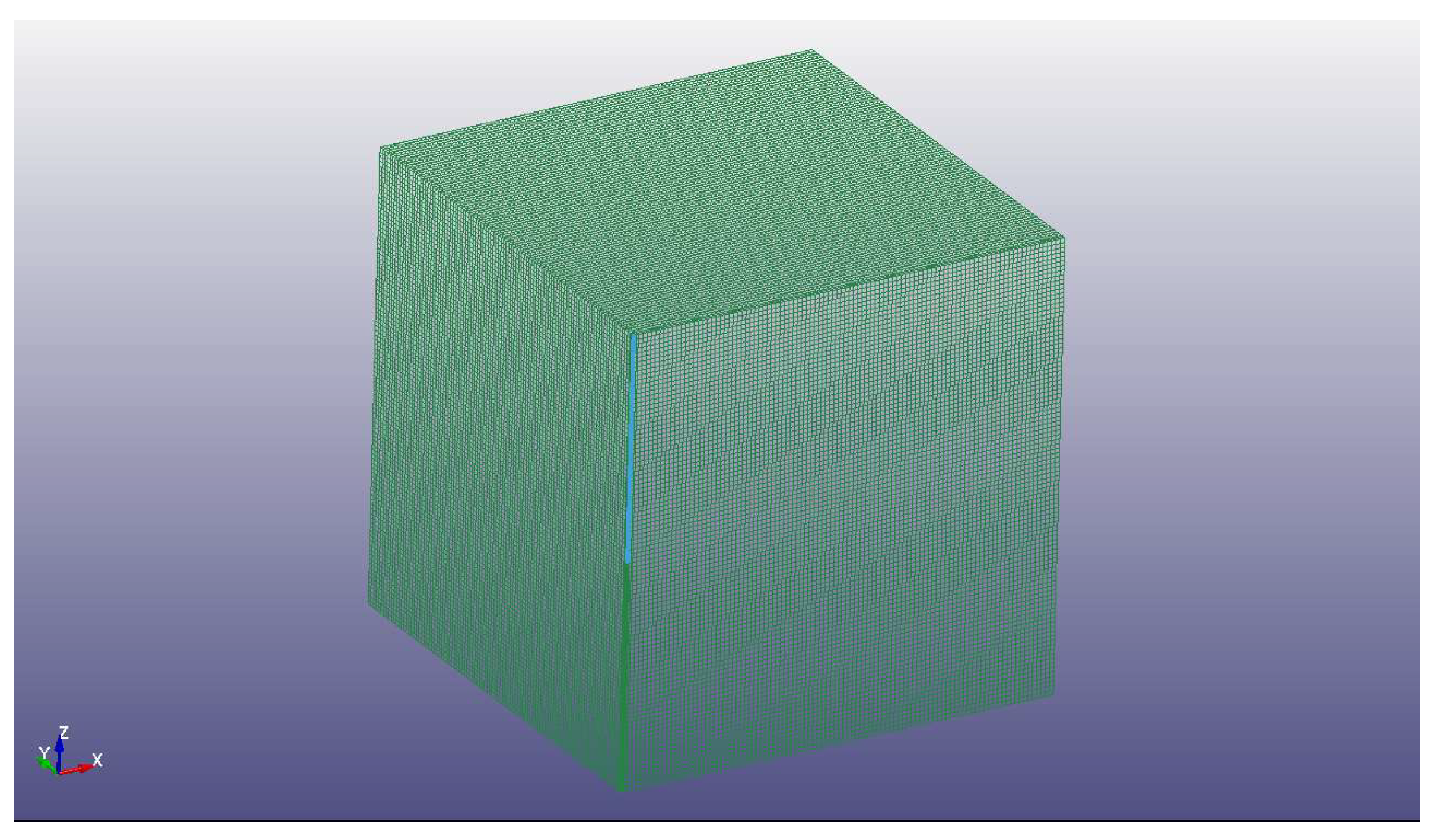
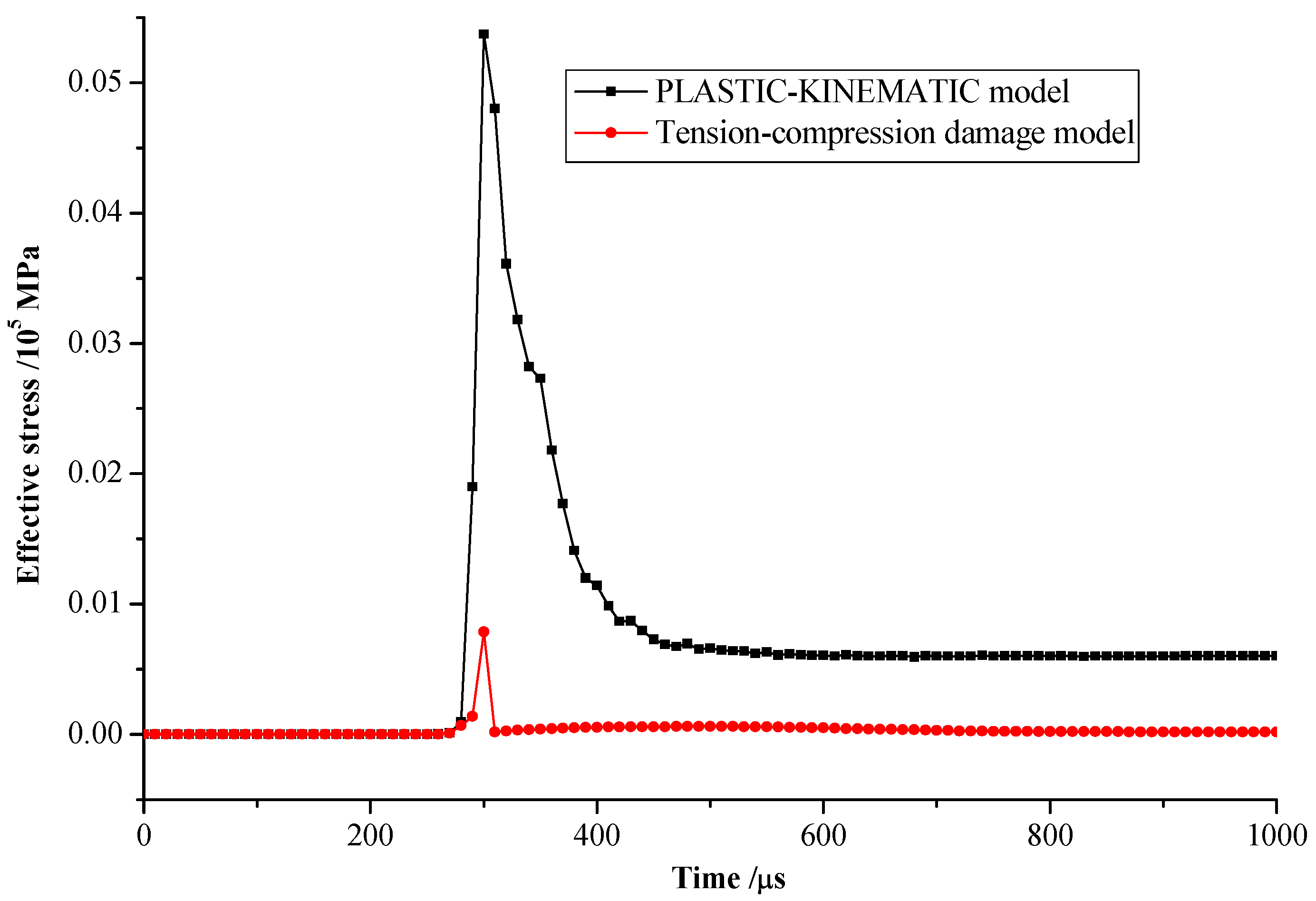



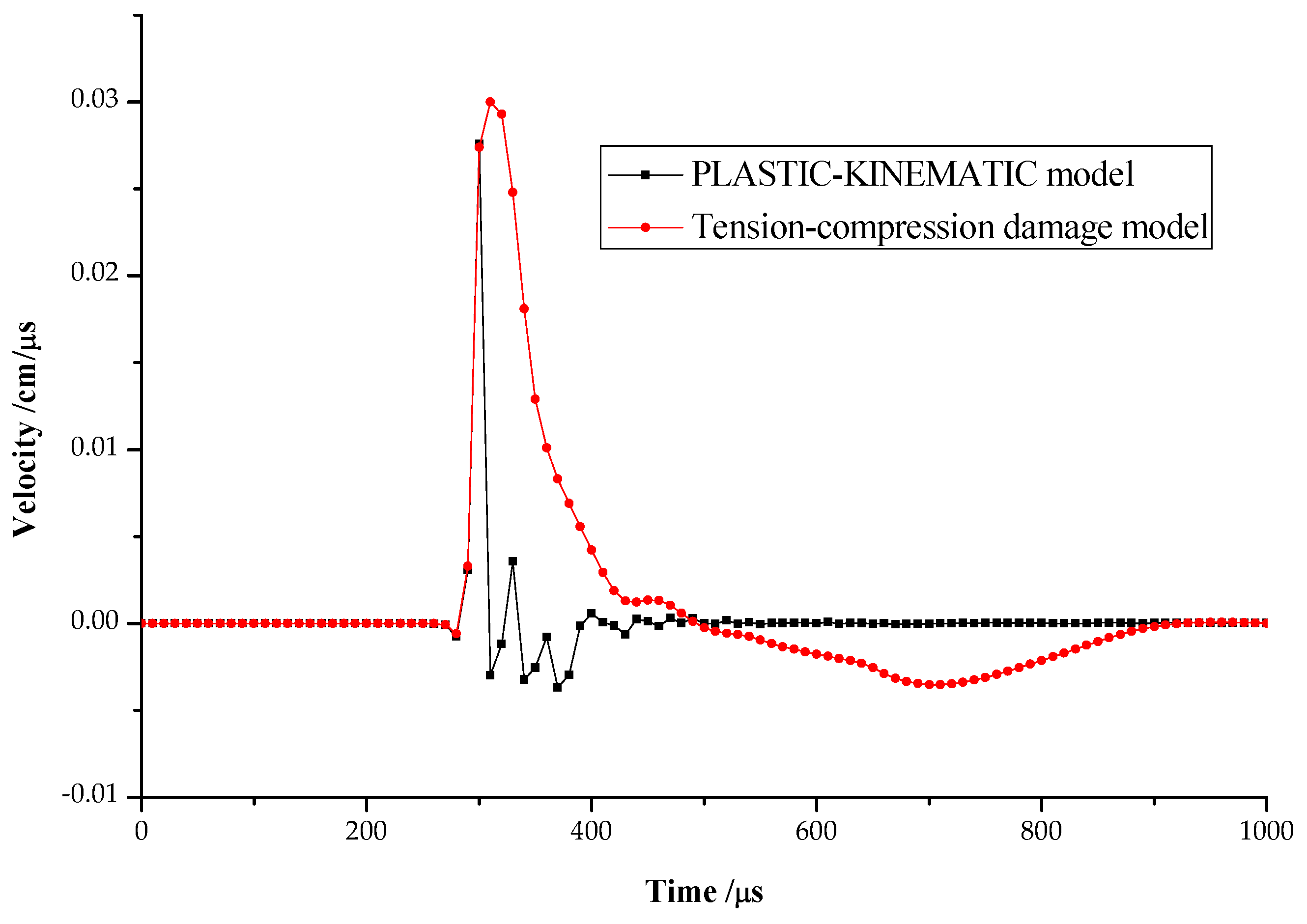

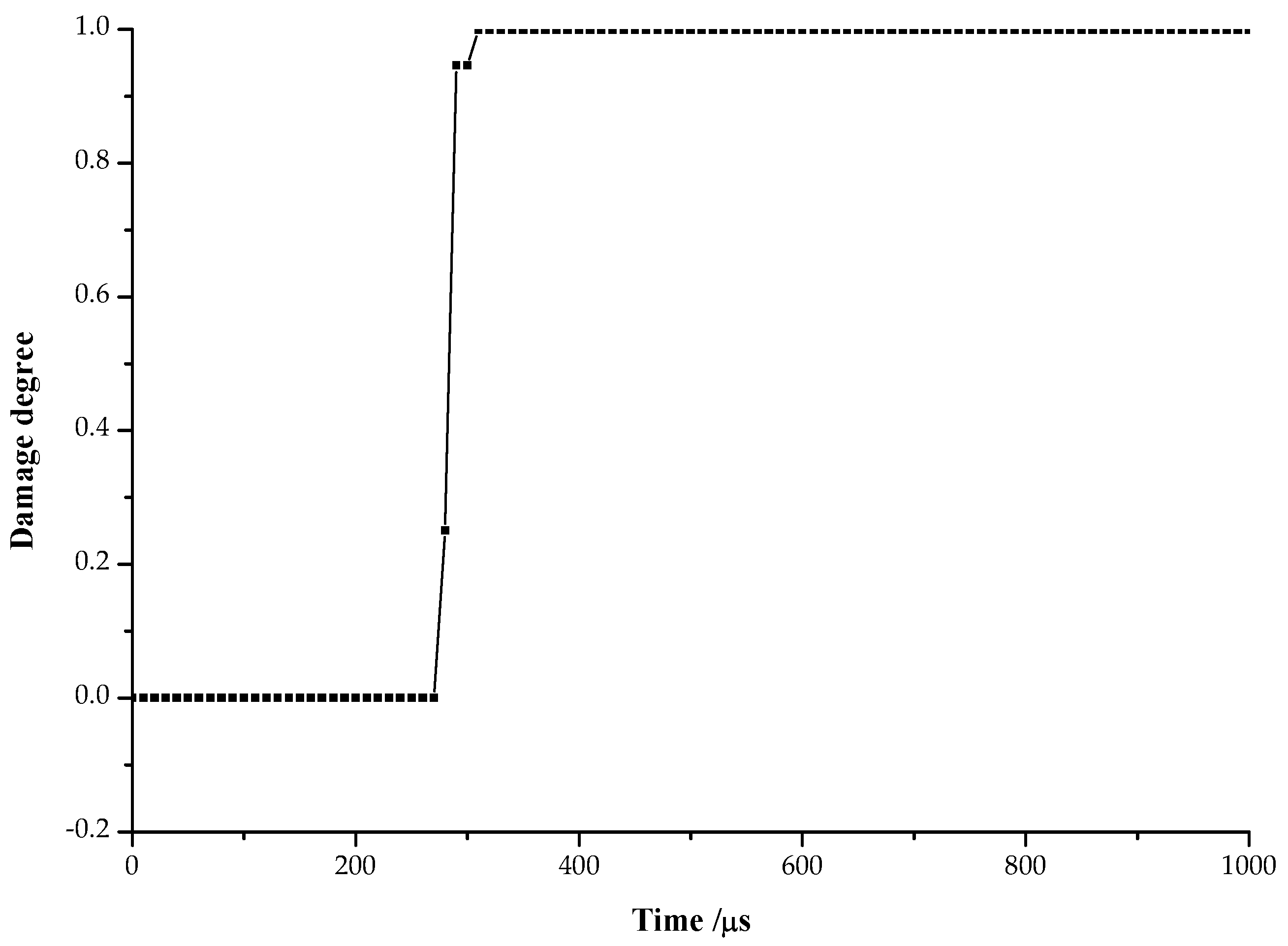

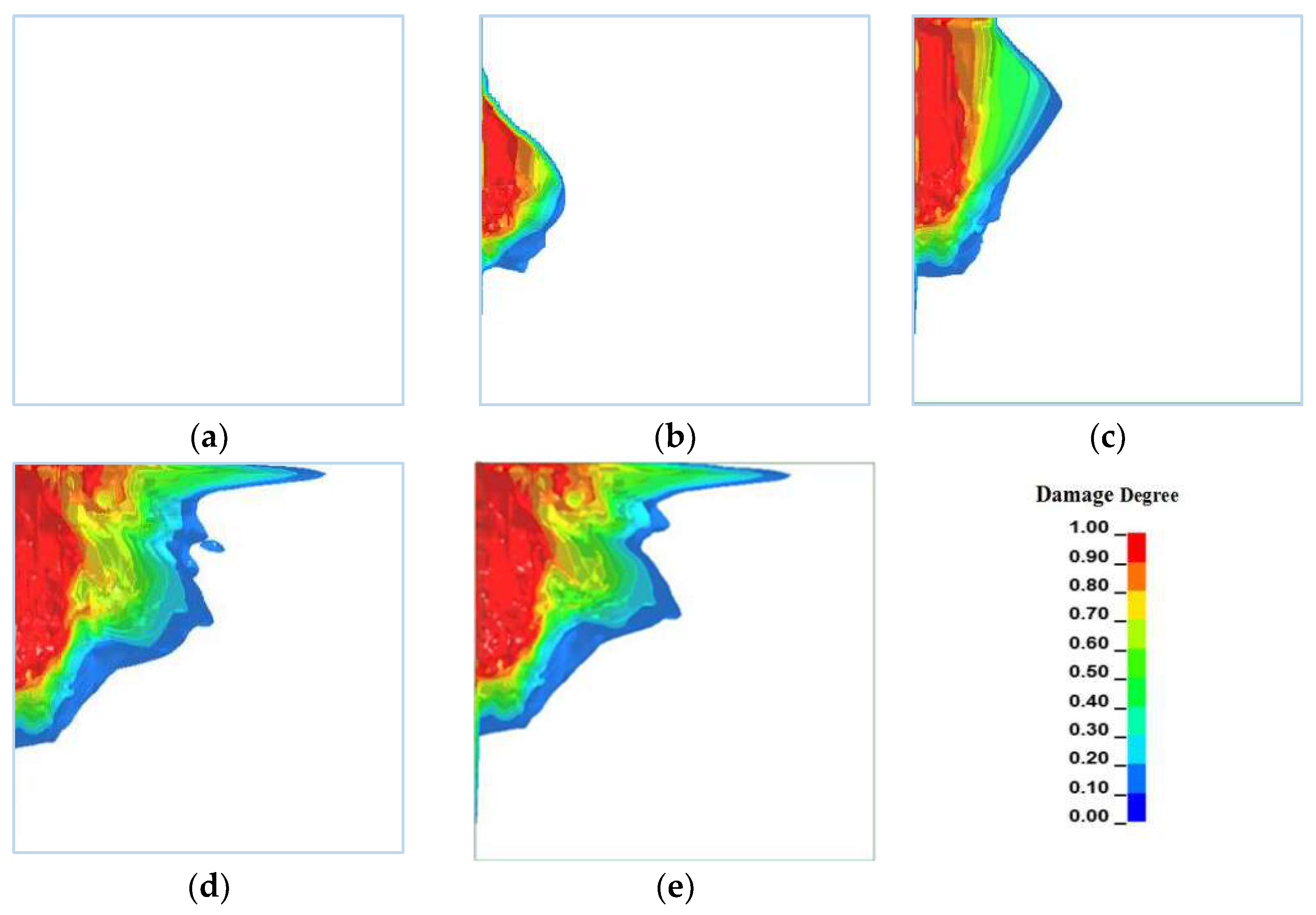
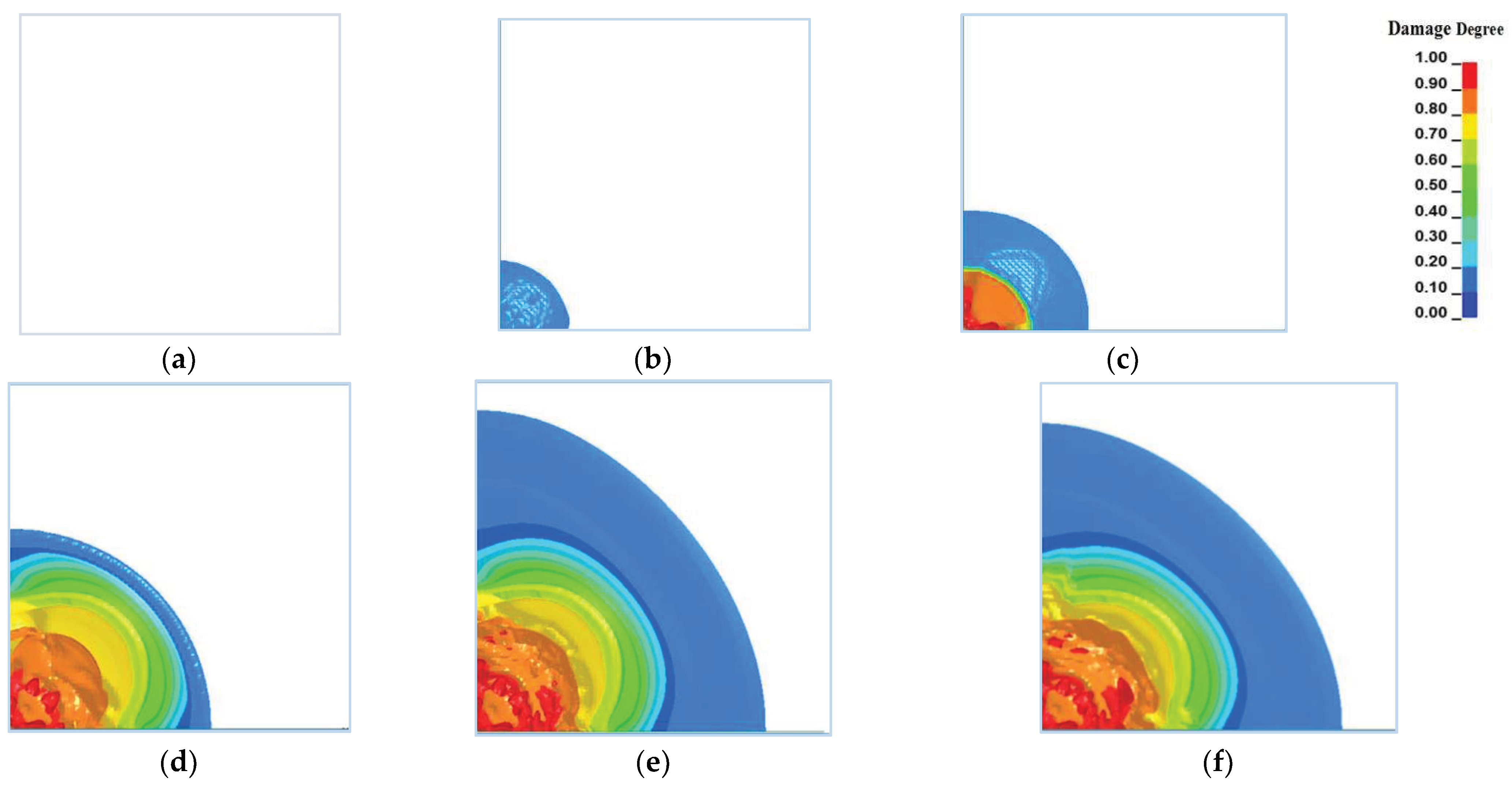



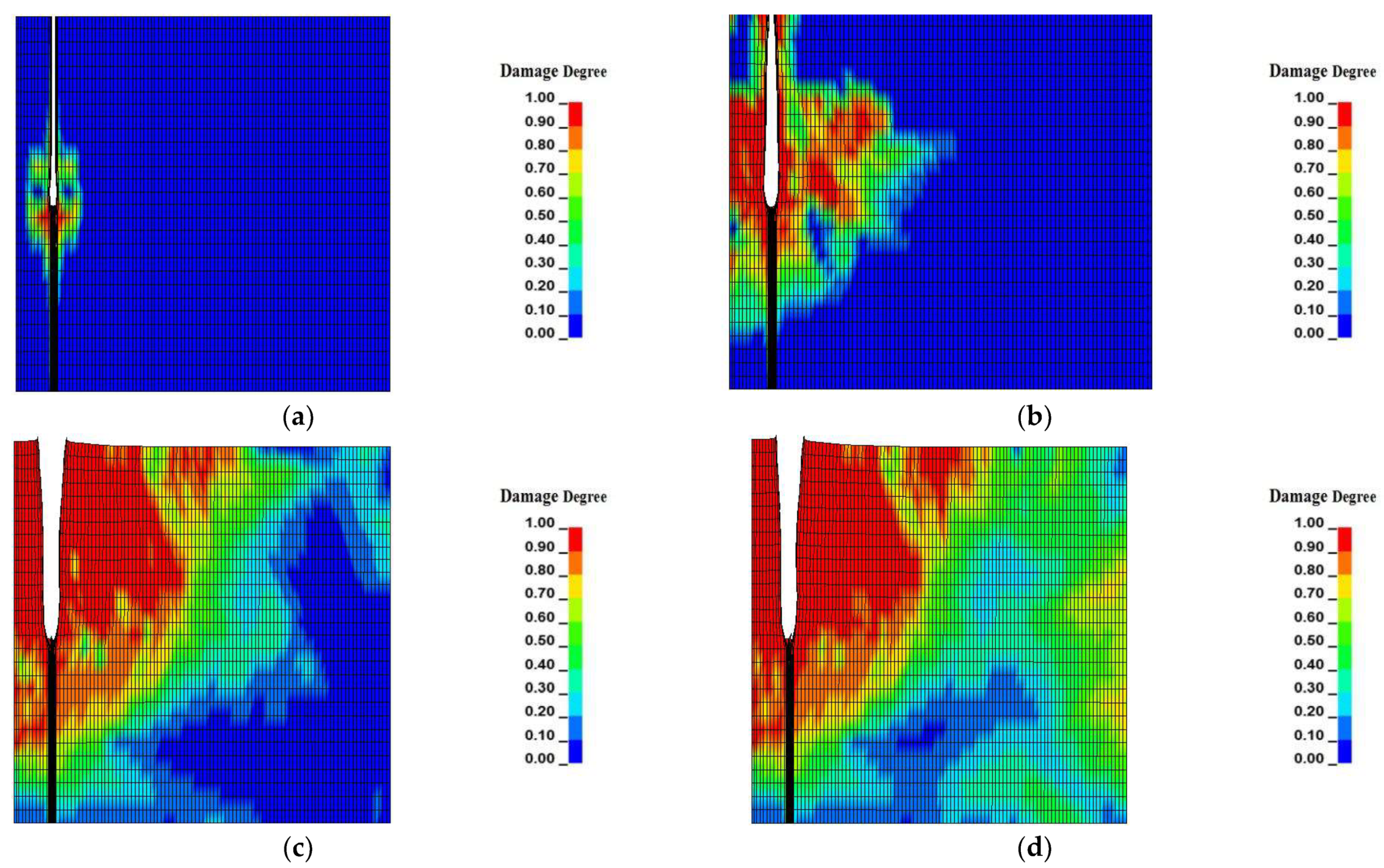
| C | |||||
| 68.69 | 40.0 | 1 | 40.0 | 75 | 4 × 107 |
| P | (MPa) | (MPa) | |||
| 5 | 2.5 | 4.5 | 5.6 | 150 | 0.5 |
| Density (g/cm3) | Blasting Speed (cm/µs) | A (GPa) | B (GPa) | R1 | R2 | ω (GPa) | E0 (GPa) | V0 |
|---|---|---|---|---|---|---|---|---|
| 1.64 | 0.693 | 374 | 3.23 | 4.15 | 0.95 | 0.3 | 7 | 1 |
| Density (kg/m3) | Dynamic Elasticity Modulus (GPa) | Poisson’s Ratio | Yield Stress (MPa) | Tangent Modulus (GPa) |
|---|---|---|---|---|
| 2680 | 50 | 0.2 | 100 | 40 |
Publisher’s Note: MDPI stays neutral with regard to jurisdictional claims in published maps and institutional affiliations. |
© 2022 by the authors. Licensee MDPI, Basel, Switzerland. This article is an open access article distributed under the terms and conditions of the Creative Commons Attribution (CC BY) license (https://creativecommons.org/licenses/by/4.0/).
Share and Cite
Xu, J.; Wang, Z.; Rui, G. Tunnel Slotting-Blasting Numerical Modeling Using Rock Tension-Compression Coupling Damage Algorithm. Appl. Sci. 2022, 12, 6714. https://doi.org/10.3390/app12136714
Xu J, Wang Z, Rui G. Tunnel Slotting-Blasting Numerical Modeling Using Rock Tension-Compression Coupling Damage Algorithm. Applied Sciences. 2022; 12(13):6714. https://doi.org/10.3390/app12136714
Chicago/Turabian StyleXu, Jiancong, Zelong Wang, and Guorong Rui. 2022. "Tunnel Slotting-Blasting Numerical Modeling Using Rock Tension-Compression Coupling Damage Algorithm" Applied Sciences 12, no. 13: 6714. https://doi.org/10.3390/app12136714






